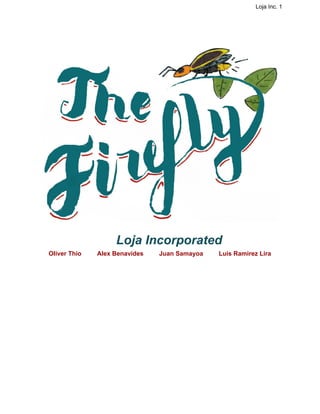
Generate Light and Power with the Firefly Bike Lamp
- 3. Loja Inc. 3 Table of Contents Executive Summary Page 4 Introduction Page 5 Current Market Offerings Product Design Page 7 Overview Cardboard Bicycle Lightemitting Diode Light Strip Efficiency Generator Wind Turbine Marketing Page 14 Environmental Impacts Page 15 Conclusion Page 18 Team Members Page 19 Oliver Thio Alex Benavides Juan Samayoa Luis Ramirez Work Cited Page 20 Resumes Page 22
- 10. Loja Inc. 10 Figure 3: Generator cover NEMA 1: Indoor use primarily to provide a degree of protection against contact with the enclosed equipment and against a limited amount of falling dirt. (IP30) NEMA 2: Indoor use to provide a degree of protection against limited amounts of falling water and dirt. (IP31) NEMA 3: Outdoor use to provide a degree of protection against windblown dust, rain, and sleet; undamaged by the formation of ice on the enclosure. (IP64) NEMA 3R: Outdoor use to provide a degree of protection against falling rain and sleet: undamaged by the formation of ice on the enclosure. (IP32) NEMA 3S: Outdoor use to provide a degree of protection against windblown dust, rain and sleet; external mechanisms remain operable while ice laden. NEMA 4: Indoor or outdoor use to provide a degree of protection against splashing water, windblown dust and rain, hose directed water; undamaged by the formation of ice on the enclosure. (IP66) NEMA 4X: Indoor or outdoor use to provide a degree of protection against splashing water, windblown dust and rain, hose directed water; undamaged by the formation of ice on the enclosure, resists corrosion. (IP66) NEMA 6: Indoor or outdoor use to provide a degree of protection against the entry of water during temporary submersion at a limited depth; undamaged by the formation of ice on the enclosure. NEMA 6P: Indoor and outdoor use to provide a degree of protection against the entry of water during prolonged submersion at a limited depth. NEMA 11: Indoor use to provide by oil immersion a degree of protection of the enclosed equipment against the corrosive effects of corrosive liquids and gases. NEMA 12,12K: Indoor use to provide a degree of protection against dust, falling dirt and dripping noncorrosive liquids. (IP65) NEMA 13: Indoor use to provide a degree of protection against dust and spraying of water, oil and noncorrosive coolants. (IP65)
- 23. Loja Inc. 23 Oliver Thio (909) 455 2344 / oliveruthio@gmail.com OBJECTIVE: To sustain a long progressive position where my abilities will best fit. EDUCATION: University of California Santa Barbara Santa Barbara, California Pursuing a Bachelor of Science degree in Computer Engineering ∙ Expected Graduation Date: June 2017 ∙ Coursework includes general chemistry, physics, calculus, technical writing, electrical circuits, and computer science. Walnut High School Walnut, California High School Diploma ACTIVITIES: Institute of Electrical and Electronics Engineers (September 2013 Present) ∙ Club of engineering majors in which we enhance our education through projects Walnut Solar Team (August 2012 – July 2013) ∙ Given the position of Head of Safety ∙ Was a programmer and mechanical engineer Link Crew Leader (June 2012 – April 2013) ∙ Gave school tours to prospective students ∙ Gained confidence and leadership Wrestling (August 2009 – December 2012) ∙ Learned perseverance and how to work in teams Model United Nations (August 2011 – April 2012) ∙ Speech and debate club on global current events. ∙ Improved public speaking skills ∙ Kept aware of global current events SKILLS: Basic circuit design, welding, soldering, coding languages: Python, C, C ++ , Java.